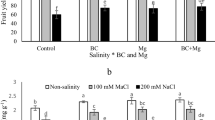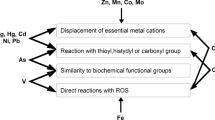Abstract
The effect of sulphide on the growth of several species of salt-marsh plants was investigated. Relative growth rates were significantly reduced in two upper-marsh species, Festuca rubra and Atriplex patula, and in the lower-marsh species Puccinellia maritima. However the growth of Salicornia europaea, a species frequently associated with sulphide-containing sediments, was unaffected. In a separate experiment the wide ranging halophyte Aster tripolium, also appeared to be tolerant of sulphide at a concentration frequently encountered in salt marshes. Sulphide pretreatment inhibited the activity of two metallo-enzymes, polyphenol oxidase and external phosphatase, in plants from the upper marsh, but had no effect on enzymes from P. maritima or S. europaea. The rate of respiration by root tissue was significantly reduced in all of the species investigated but whereas the uptake of 86rubidium was markedly inhibited in the other three species, uptake by S. europaea showed a significant stimulation. Similarly, whereas sulphide-grown plants of F. rubra, A. patula and P. maritima had a considerably reduced tissue iron content, the total iron concentration in S. europaea tissues was comparable to that of the controls. When the sulphide-tolerant species A. tripolium was grown in sulphide-containing media there was no significant effect on the tissue concentration of any of the elements investigated. These results are discussed in relation to possible mechanisms of sulphide toxicity and resistance.
Similar content being viewed by others
References
Allam, A. I., Pitts, G. & Hollis, J. P., 1972. Sulphide determinations in submerged soils with an ion-selective electrode. Soil Sci. 114: 456–467.
Allen, S. E., 1974. Chemical Analysis of Ecological Materials. Blackwell, Oxford.
Carlson, P. R. Jr. & Forrest, J., 1982. Uptake of dissolved sulfide by Spartina alterniflora: evidence from natural sulfur isotope abundance ratios. Science 216: 158–165.
Dickson, D. M., Wyn Jones, R. G. & Davenport, J., 1980. Steady state osmotic adaptation in Ulva lactuca. Planta 150: 158–165.
Ford, H. W., 1965. Bacterial metabolites that effect citrus root survival in soils subject to flooding. Proc. Am. Soc. Hort. Sci. 86: 205–212.
Hollis, J. P., 1967. Toxicant diseases of rice. Bull. La Agric. Exp. Stn. 614–621.
Hollis, J. P., Allam, A. I., Pitts, G., Joshi, M. M. & Ibrahim, I. K. A., 1975. Sulphide diseases of rice on iron-excess soils. Acta Phytopathol. Acad. Scient. Hung. 10: 329–341.
Ingold, A., 1982. The effects of sulphide toxicity on the distribution of higher plant species in salt marshes. Ph.D. Thesis. University of London, England.
Joshi, M. M., Ibrahim, I. K. A. & Hollis, J. P., 1975. Hydrogen sulphide: effects on the physiology of rice plants and relation to straithead disease. Phytopathology 65: 1165–1170.
Keilin, D., 1928. Cytochrome and respiratory enzymes. Proc. Roy. Soc. (London) B104: 206–252.
King, G. M., Klug, M. J., Wiegert, R. G. & Chalmers, A. G., 1982. Relation of soil water movement and sulfide concentration to Spartina alterniflora production in a Georgia salt marsh. Science 218: 61–63.
Lauchli, A. & Epstein, E., 1970. Transport of potassium and rubidium in plant roots. Significance of calcium. Plant Physiol. Lancaster 45: 639–641.
McCullough, J., 1967. The determination of ammonia in whole blood by a direct calorimetric method. Clin. Chim. Acta 17: 197–304.
Mendelssohn, I. A. & Postek, M. T., 1982. Elemental analysis of deposits on the roots of Spartina alterniflora Loisel. Am. J. Bot. 69: 904–912.
Mitsui, S. & Kamazawa, K., 1964. Dynamic studies on the nutrient uptake by crop plants. Part 41: Nutrient and Redox conditions. Soil Sci. Plant Nutr. 10: 227 (Abstracts).
Ponnamperuma, F. N., 1972. The chemistry of submerged soils. Adv. Agron. 24: 29–36.
Sekiya, J., Schmidt, A., Wilson, L. G. & Filner, P., 1982. Emission of hydrogen sulphide by leaf tissue in response to L-Cysteine. Plant Physiol. 70: 430–436.
Skyring, G. W., Oshrain, R. L. & Weibe, W. J., 1979. Sulphate reduction rates in Georgia marshland soils. Geomicrobiol. J. 1: 389–400.
Smirnoff, N., 1981. Iron tolerance and the role of aerenchyma in wetland palnts. Ph.D. Thesis. University of St. Andrews, St. Andrews, Scotland.
Stewart, G. R., Lahrer, R., Ahmad, I. & Lee, J. A., 1979. Nitrogen metabolism and salt tolerance in higher plant halophytes. In: R. L. Jeffries & A. J. Davy (eds.), Ecological Processes in Coastal Environments. pp. 211–227. Blackwell, Oxford.
Teal, J. M. & Kanwisher, J. W., 1966. Gas transport in the marsh grass Spartina alterniflora. J. Expt. Bot. 17: 355–361.
Umbreit, W. W., Burris, R. H. & Stauffer, J. F., 1964. Manometric Techniques and Related Methods for the Study of Tissue Metabolism, 4th ed. Burgess, Minneapolis.
Author information
Authors and Affiliations
Rights and permissions
About this article
Cite this article
Havill, D.C., Ingold, A. & Pearson, J. Sulphide tolerance in coastal halophytes. Vegetatio 62, 279–285 (1985). https://doi.org/10.1007/BF00044754
Accepted:
Issue Date:
DOI: https://doi.org/10.1007/BF00044754




